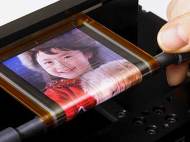Sony OTFT-driven OLED display can be wrapped around a pen
 The folks from Sony announced that they have developed a super-flexible OTFT-driven full color OLED display which can be wrapped around a thin cylinder. An OTFT (Organic Thin-Film Transistor) is a thin-film transistor with organic (carbon-based compound) semiconductor. It has high mechanical flexibility and therefore it is expected to realize thin, light-weight, mechanical-shock resistant and form-factor enhanced electronic devices.
The folks from Sony announced that they have developed a super-flexible OTFT-driven full color OLED display which can be wrapped around a thin cylinder. An OTFT (Organic Thin-Film Transistor) is a thin-film transistor with organic (carbon-based compound) semiconductor. It has high mechanical flexibility and therefore it is expected to realize thin, light-weight, mechanical-shock resistant and form-factor enhanced electronic devices.
To create the display, Sony developed OTFTs with an original organic semiconductor material (a PXX derivative) with eight times of the current modulation of conventional OTFTs (comparison between OTFTs with pentacene (C22H14) and PXX derivative). This was achieved due to the development of integration technologies of OTFTs and OLEDs on an ultra-thin 20 μm thick flexible substrate (a flexible on-panel gate-driver circuit with OTFTs which is able to get rid of conventional rigid driver IC chips interfering roll-up of a display) and soft organic insulators for all the insulators in the integration circuits.
By combining these technologies, Sony successfully demonstrated the OLED panel which is capable to reproduce moving images while it was being rolled-up and stretched around a cylinder with a radius of 4 mm (current minimum bending radius). The OTFT-driven OLED display measures 4.1-inches wide and just 80 micrometers thick. It has a resolution of 432 x 240 pixels at 121 pixels per inch (ppi), which Sony says makes it the world’s highest-resolution OTFT-driven OLED display. It can produce 16.8 million colors with a peak brightness of over 100 cd/m2 peak and contrast ratio of greater than 1000:1.
In order to enhance flexibility of the display, Sony has developed organic insulators for all the insulators in the OTFT and OLED integration circuit. These organic insulators can be formed with the solution process in the atmosphere which is requires fewer steps, and consumes materials and energy more efficiently – thus has a smaller environmental footprint – compared to the conventional high temperature vacuum semiconductor process which use inorganic, silicon materials.
Folks from Sony claim that there was no clear degradation in the display’s ability to reproduce moving images even after 1000 cycles of repeatedly rolling-up and stretching the display. They will continue to improve the performance and reliability of the flexible organic display because they plan to incorporate these displays into upcoming thin, light-weight, durable and mobile devices with enhanced form-factor.









Another example of MINIATURE. Very good invention.
Dr.A.Jagadeesh Nellore(AP),India